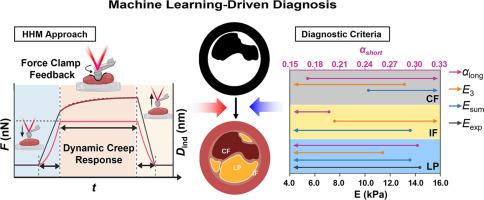破译动脉粥样硬化斑块的复杂力学原理:分层理论-微流变学混合方法。
IF 9.4
1区 医学
Q1 ENGINEERING, BIOMEDICAL
引用次数: 0
摘要
了解动脉粥样硬化斑块在易破裂尺度上的粘弹性对评估其脆弱性至关重要。在此,我们开发了一种混合层次理论-微流变学(HHM)方法,能够分析斑块内不同空间尺度的多尺度力学变化和区域组织粘弹性的分布变化。我们揭示了斑块中普遍存在的两级幂律流变学,其特征是不同的幂律指数(α短和α长),可作为斑块成分的力学指标并评估力学梯度。我们进一步提出了一种自相似分层理论,可有效地划分从细胞质、细胞到组织层面的斑块异质性。此外,我们提出的多层感知器模型还能解决斑块内部的粘弹性异质性和梯度问题,为识别不稳定斑块提供了一种前景广阔的诊断策略。这些发现不仅加深了我们对斑块力学的理解,还为心血管疾病管理的创新诊断方法铺平了道路。意义声明:我们的研究开创了一种混合层次理论-微流变学(HHM)方法,用于剖析动脉粥样硬化斑块错综复杂的粘弹性,重点关注斑块帽纤维化、脂质池和内膜纤维化等不同的组成部分。我们揭示了一种普遍的两阶段幂律流变学,它捕捉到了斑块结构间的力学变化。所提出的分层模型能很好地捕捉从细胞质、细胞到组织层面的粘弹性变化。基于新提出的标记,我们进一步开发了机器学习(ML)诊断模型,为评估斑块成分和异质性设定了精确的标准。这项工作不仅揭示了斑块内部的全面机械异质性,还引入了基于机械标记的 ML 策略来评估斑块状况,为理解和诊断动脉粥样硬化风险提供了重要的飞跃。本文章由计算机程序翻译,如有差异,请以英文原文为准。

Deciphering the complex mechanics of atherosclerotic plaques: A hybrid hierarchical theory-microrheology approach
Understanding the viscoelastic properties of atherosclerotic plaques at rupture-prone scales is crucial for assessing their vulnerability. Here, we develop a Hybrid Hierarchical theory-Microrheology (HHM) approach, enabling the analysis of multiscale mechanical variations and distribution changes in regional tissue viscoelasticity within plaques across different spatial scales. We disclose a universal two-stage power-law rheology in plaques, characterized by distinct power-law exponents (αshort and αlong), which serve as mechanical indexes for plaque components and assessing mechanical gradients. We further propose a self-similar hierarchical theory that effectively delineates plaque heterogeneity from the cytoplasm, cell, to tissue levels. Moreover, our proposed multi-layer perceptron model addresses the viscoelastic heterogeneity and gradients within plaques, offering a promising diagnostic strategy for identifying unstable plaques. These findings not only advance our understanding of plaque mechanics but also pave the way for innovative diagnostic approaches in cardiovascular disease management.
Statement of significance
Our study pioneers a Hybrid Hierarchical theory-Microrheology (HHM) approach to dissect the intricate viscoelasticity of atherosclerotic plaques, focusing on distinct components including cap fibrosis, lipid pools, and intimal fibrosis. We unveil a universal two-stage power-law rheology capturing mechanical variations across plaque structures. The proposed hierarchical model adeptly captures viscoelasticity changes from cytoplasm, cell to tissue levels. Based on the newly proposed markers, we further develop a machine learning (ML) diagnostic model that sets precise criteria for evaluating plaque components and heterogeneity. This work not only reveals the comprehensive mechanical heterogeneity within plaques but also introduces a mechanical marker-based ML strategy for assessing plaque conditions, offering a significant leap towards understanding and diagnosing atherosclerotic risks.
求助全文
通过发布文献求助,成功后即可免费获取论文全文。
去求助
来源期刊

Acta Biomaterialia
工程技术-材料科学:生物材料
CiteScore
16.80
自引率
3.10%
发文量
776
审稿时长
30 days
期刊介绍:
Acta Biomaterialia is a monthly peer-reviewed scientific journal published by Elsevier. The journal was established in January 2005. The editor-in-chief is W.R. Wagner (University of Pittsburgh). The journal covers research in biomaterials science, including the interrelationship of biomaterial structure and function from macroscale to nanoscale. Topical coverage includes biomedical and biocompatible materials.
 求助内容:
求助内容: 应助结果提醒方式:
应助结果提醒方式:


